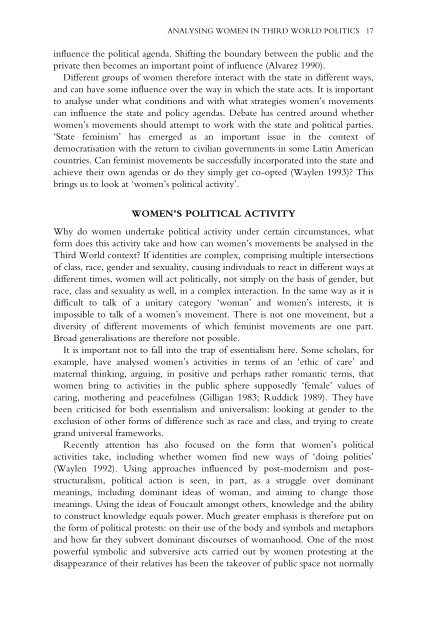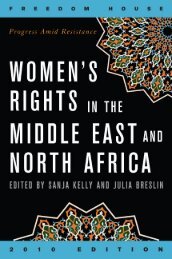Women and Politics in the Third World
Women and Politics in the Third World
Women and Politics in the Third World
Create successful ePaper yourself
Turn your PDF publications into a flip-book with our unique Google optimized e-Paper software.
ANALYSING WOMEN IN THIRD WORLD POLITICS 17<br />
<strong>in</strong>fluence <strong>the</strong> political agenda. Shift<strong>in</strong>g <strong>the</strong> boundary between <strong>the</strong> public <strong>and</strong> <strong>the</strong><br />
private <strong>the</strong>n becomes an important po<strong>in</strong>t of <strong>in</strong>fluence (Alvarez 1990).<br />
Different groups of women <strong>the</strong>refore <strong>in</strong>teract with <strong>the</strong> state <strong>in</strong> different ways,<br />
<strong>and</strong> can have some <strong>in</strong>fluence over <strong>the</strong> way <strong>in</strong> which <strong>the</strong> state acts. It is important<br />
to analyse under what conditions <strong>and</strong> with what strategies women’s movements<br />
can <strong>in</strong>fluence <strong>the</strong> state <strong>and</strong> policy agendas. Debate has centred around whe<strong>the</strong>r<br />
women’s movements should attempt to work with <strong>the</strong> state <strong>and</strong> political parties.<br />
‘State fem<strong>in</strong>ism’ has emerged as an important issue <strong>in</strong> <strong>the</strong> context of<br />
democratisation with <strong>the</strong> return to civilian governments <strong>in</strong> some Lat<strong>in</strong> American<br />
countries. Can fem<strong>in</strong>ist movements be successfully <strong>in</strong>corporated <strong>in</strong>to <strong>the</strong> state <strong>and</strong><br />
achieve <strong>the</strong>ir own agendas or do <strong>the</strong>y simply get co-opted (Waylen 1993)? This<br />
br<strong>in</strong>gs us to look at ‘women’s political activity’.<br />
WOMEN’S POLITICAL ACTIVITY<br />
Why do women undertake political activity under certa<strong>in</strong> circumstances, what<br />
form does this activity take <strong>and</strong> how can women’s movements be analysed <strong>in</strong> <strong>the</strong><br />
<strong>Third</strong> <strong>World</strong> context? If identities are complex, compris<strong>in</strong>g multiple <strong>in</strong>tersections<br />
of class, race, gender <strong>and</strong> sexuality, caus<strong>in</strong>g <strong>in</strong>dividuals to react <strong>in</strong> different ways at<br />
different times, women will act politically, not simply on <strong>the</strong> basis of gender, but<br />
race, class <strong>and</strong> sexuality as well, <strong>in</strong> a complex <strong>in</strong>teraction. In <strong>the</strong> same way as it is<br />
difficult to talk of a unitary category ‘woman’ <strong>and</strong> women’s <strong>in</strong>terests, it is<br />
impossible to talk of a women’s movement. There is not one movement, but a<br />
diversity of different movements of which fem<strong>in</strong>ist movements are one part.<br />
Broad generalisations are <strong>the</strong>refore not possible.<br />
It is important not to fall <strong>in</strong>to <strong>the</strong> trap of essentialism here. Some scholars, for<br />
example, have analysed women’s activities <strong>in</strong> terms of an ‘ethic of care’ <strong>and</strong><br />
maternal th<strong>in</strong>k<strong>in</strong>g, argu<strong>in</strong>g, <strong>in</strong> positive <strong>and</strong> perhaps ra<strong>the</strong>r romantic terms, that<br />
women br<strong>in</strong>g to activities <strong>in</strong> <strong>the</strong> public sphere supposedly ‘female’ values of<br />
car<strong>in</strong>g, mo<strong>the</strong>r<strong>in</strong>g <strong>and</strong> peacefulness (Gilligan 1983; Ruddick 1989). They have<br />
been criticised for both essentialism <strong>and</strong> universalism: look<strong>in</strong>g at gender to <strong>the</strong><br />
exclusion of o<strong>the</strong>r forms of difference such as race <strong>and</strong> class, <strong>and</strong> try<strong>in</strong>g to create<br />
gr<strong>and</strong> universal frameworks.<br />
Recently attention has also focused on <strong>the</strong> form that women’s political<br />
activities take, <strong>in</strong>clud<strong>in</strong>g whe<strong>the</strong>r women f<strong>in</strong>d new ways of ‘do<strong>in</strong>g polities’<br />
(Waylen 1992). Us<strong>in</strong>g approaches <strong>in</strong>fluenced by post-modernism <strong>and</strong> poststructuralism,<br />
political action is seen, <strong>in</strong> part, as a struggle over dom<strong>in</strong>ant<br />
mean<strong>in</strong>gs, <strong>in</strong>clud<strong>in</strong>g dom<strong>in</strong>ant ideas of woman, <strong>and</strong> aim<strong>in</strong>g to change those<br />
mean<strong>in</strong>gs. Us<strong>in</strong>g <strong>the</strong> ideas of Foucault amongst o<strong>the</strong>rs, knowledge <strong>and</strong> <strong>the</strong> ability<br />
to construct knowledge equals power. Much greater emphasis is <strong>the</strong>refore put on<br />
<strong>the</strong> form of political protests: on <strong>the</strong>ir use of <strong>the</strong> body <strong>and</strong> symbols <strong>and</strong> metaphors<br />
<strong>and</strong> how far <strong>the</strong>y subvert dom<strong>in</strong>ant discourses of womanhood. One of <strong>the</strong> most<br />
powerful symbolic <strong>and</strong> subversive acts carried out by women protest<strong>in</strong>g at <strong>the</strong><br />
disappearance of <strong>the</strong>ir relatives has been <strong>the</strong> takeover of public space not normally




